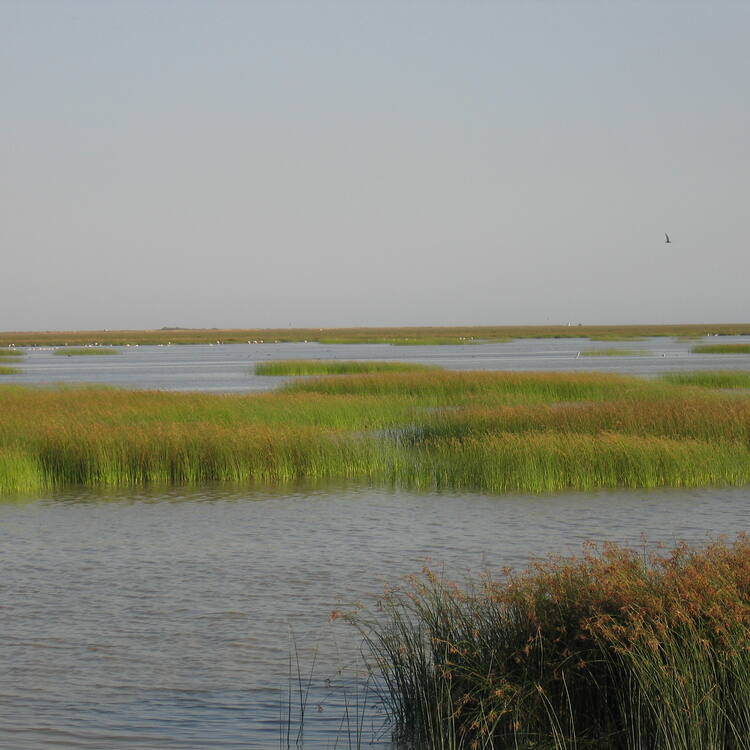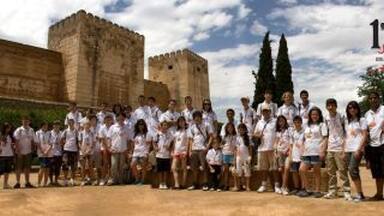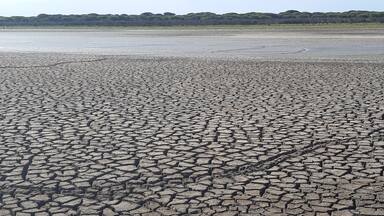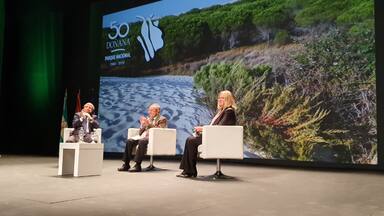Doñana National Park
Doñana National Park
Doñana National Park in Andalusia occupies the right bank of the Guadalquivir river at its estuary on the Atlantic Ocean. It is notable for the great diversity of its biotopes, especially lagoons, marshlands, fixed and mobile dunes, scrub woodland and maquis. It is home to five threatened bird species. It is one of the largest heronries in the Mediterranean region and is the wintering site for more than 500,000 water fowl each year.
Description is available under license CC-BY-SA IGO 3.0
Parc national de Doñana
Situé en Andalousie, le parc de Doñana occupe la rive droite du Guadalquivir, à son estuaire sur l'océan Atlantique. Il est remarquable par la grande diversité de ses biotopes, notamment lagunes, marais, dunes fixes et mobiles, buissons et maquis. Il est l'habitat de cinq espèces d'oiseaux menacées. C'est l'une des plus grandes héronnières de la région méditerranéenne et le site d'hivernage de plus de 500 000 oiseaux d'eau.
Description is available under license CC-BY-SA IGO 3.0
منتزه دنيانا الوطني
يقع المنتزه في الأندلس عند الضفّة اليمنى لنهر "غوادالكبير" (الوادي الكبير) في مصبّه على المحيط الأطلسي. وهو معروف لتنوّع مداه الجغرافي من بحيرات شاطئية ومستنقعات وكثب ثابتة ومتحرّكة وغابات صغيرة وأجمة. وهو موطن خمسة أصناف من الطيور المهددة وأعظم مواطن أعشاش مالك الحزين في المنطقة المتوسطية والموقع الذي يبيت فيه أكثر من 500000 عصفور مائي في فصل الشتاء.
source: UNESCO/CPE
Description is available under license CC-BY-SA IGO 3.0
多南那国家公园
安达卢西亚的多南那国家公园位于瓜达尔基维尔河汇入大西洋入海口的右岸。该国家公园以生态系统的多样性而著称,这里有环礁湖、沼泽地、固定和移动的沙丘、丛林地和灌木地带。这里还生活着5种濒危鸟类,同时,此地还是地中海地区最大的鸟类蛋孵化地之一,每年都有超过50万只水禽在这里栖息越冬。
source: UNESCO/CPE
Description is available under license CC-BY-SA IGO 3.0
Национальный парк Доньяна
Национальный парк Доньяна в Андалусии занимает правобережье эстуария реки Гвадалквивир вблизи ее впадения в Атлантический океан. Эта местность знаменита разнообразием своих ландшафтов, среди которых – лагуны, болота, подвижные и закрепленные дюны, кустарники и леса, маквис. Здесь обитают представители пяти редких и исчезающих видов птиц, обосновалась одна из крупнейших в Средиземноморье колоний цапель, а на зимовку сюда прилетает свыше 500 тыс. водоплавающих птиц.
source: UNESCO/CPE
Description is available under license CC-BY-SA IGO 3.0
Parque Nacional de Doñana
Situado en Andalucía, el parque de Doñana ocupa la margen derecha del estuario del río Guadalquivir, cerca de su desembocadura en el Atlántico. Es notable por la gran variedad de sus biotopos: lagunas, marismas, matorrales, monte bajo mediterráneo y dunas móviles y fijas. Es el hábitat de cinco especies de aves en peligro de extinción, posee una de las mayores poblaciones de garzas de la región mediterránea y sirve de refugio invernal a más de medio millón de aves acuáticas.
source: UNESCO/CPE
Description is available under license CC-BY-SA IGO 3.0
ドニャーナ国立公園
アンダルシア地方にある同国最大の国立公園。面積は507k㎡強。海沿いのサンゴ礁から湿原、内陸のやぶ地、砂丘林まで、多様な植物相が見られる。絶滅のおそれのある5種類の鳥が生息し、地中海地方ではアオサギの最大の営巣地の一つ。冬季には毎年50万羽もの水鳥が訪れる。スペインオオヤマネコの生息地でもある。source: NFUAJ
Nationaal park Doñana
Het nationaal park Doñana in Andalusië ligt op de rechteroever van de Guadalquivir rivier bij de monding van de Atlantische oceaan. Het park is opmerkelijk vanwege de grote diversiteit van haar biotopen. Zo zijn er lagunes, moerassen, vaste zandduinen en wandelende groepen duinen, struikbos en struikgewas. Het is de thuisbasis van vijf bedreigde vogelsoorten. Het is een van de grootste reigerkolonies in het Middellandse zeegebied en het overwinteringsgebied voor meer dan 500.000 watervogels per jaar. De fauna van het park bestaat onder meer uit 8 soorten vissen, 10 soorten amfibieën, 19 soorten reptielen, 30 soorten zoogdieren en 360 vogelsoorten.
Source: unesco.nl
Outstanding Universal Value
Brief synthesis
Doñana National Park, at the southwestern tip of Spain, is an exceptional wetland located on the right bank of the Guadalquivir River where it empties into the Atlantic. The interrelation of the ocean with the Guadalquivir River has been the fundamental factor that has generated the great diversity of the Park’s ecosystems and landscapes. Along the river estuary are 38 kilometres of unspoilt beaches fringed by fixed and mobile dunes, the most important in Europe. Coniferous and oak forests, shrubs, as well as lagoons, marshes and peat bogs, all in an excellent state of conservation, are also an integral part of the property. Covering 54,252 ha, the Park is one of the few protected areas in Europe where all these habitat types converge.
Doñana has valuable fauna (notably birds) and flora (including many endemic species), and is an essential refuge for several endangered species, including the Iberian Lynx (Lynx pardinus) (one of the world’s most threatened felines), the Iberian Imperial Eagle (Aquila adlberti), the Marbled Teal (Marmorenetta angustirostris), the White-headed Duck (Oxyura leucocephala), the Crested Coot (Fulica cristata), the Ferruginous Scaup (Aythya nyroca ), the Bittern (Botaurus stellaris) and the Black Tern (Chlidonias niger). The Park is also of international importance due to the many species and specimens of breeding, wintering and migrating birds that find in this wetland a place of rest and an irreplaceable refuge on the East-Atlantic flyway.
Historical references to Doñana span 700 years. Meanwhile its many resources, including its wealth of game, afforestation, fisheries and seafood, have made it not only a favourite royal hunting reserve, but also a source of essential provisions for the inhabitants of this territory. Its natural beauty has inspired writers and artists including Goya, Quevedo, Juan Ramón Jiménez and Caballero Bonald. The pilgrimage to the Sanctuary of El Rocío, one of the most significant Marian devotional events in the world, combines natural and spiritual elements, thus making Doñana a symbolic and religious place.
Criterion (vii): Many authors have stressed the exceptional beauty, the solitude offered by its landscapes and the untouched nature of Doñana, and in particular its vast wild expanses which include various types of habitats (marshes, forests, beaches, dunes, lagoons). Its 38 km beach is completely virgin, and its marshes are home to spectacular colonies of nesting birds.
Criterion (ix): The marshes of the Guadalquivir River are an example of geological processes developed during the Pleistocene. Doñana contains the last area of Guadalquivir marshes unaltered by agriculture or urban development. The marshes are the result of the sinking of the Upper Miocene and Lower Pliocene continental plate, which resulted in a depression later filled with fluvial and aeolian deposits.
In addition, Doñana has an exceptionally wide range of well-preserved coastal freshwater and swampy ecosystems, where, in addition to the vast expanse of marshes, permanent and, especially, temporary lagoons abound which may appear in particularly rainy years. This heterogeneity of environments makes it one of the most important centres of biodiversity in Europe.
Likewise, its various sandy ecosystems dominated by the Mediterranean scrub, with the presence of brushwood and open forests, are very suitable habitats for carnivorous species such as the Iberian Lynx (Lynx pardinus) and large ungulates. In the coastal area, the constant deposition of sandbanks and the generation of very dynamic and active mobile trains of dunes are distinctive. These dune systems are among the largest in continental Europe and clearly show the primary and secondary stages of vegetation succession in the region.
Criterion (x): The Park is home to a great diversity of flora and fauna, in particular an avifauna made up of around 360 nesting and migratory species. It has breeding populations of several globally threatened faunal species such as Marbled Teal (Marmorenetta angustirostris), White-headed Duck (Oxyura leucocephala), Iberian Imperial Eagle (Aquila adlberti) and Iberian Lynx (Lynx pardinus). The flora includes Chicoria hueca (Avellara fistulosa), Onopordun hinojense, Adenocarpus gibssianus, and Rorippa valdes-bermejoi. Doñana and in particular its marshes are recognized as a wetland of international importance for many species of waterfowl, breeding and wintering, and it is a bottleneck on the migratory route between Western Europe and West Africa, with concentrations of about 500,000 wintering birds per year.
Mentioning only the best-known kingdoms, more than 1,400 species of flora have been identified, representing 114 families of superior plants, some endemic and new to science. This diversity of species is also reflected in the variety of environments representative of saline, sweet, lentic or lotic aquatic ecosystems, or xerophilic, hydrophilic, dune or forest terrestrial ecosystems.
The extraordinary richness of the fauna of Doñana is a direct consequence of the diversity of the mosaic of habitats and ecosystems that it shelters. Birds are probably the best-known group, with some 360 species, but there are also 38 different species of mammals. The Doñana area is considered one of the most important in Spain for reptiles and amphibians, having been classified as an area of exceptional herpetological interest with 42 species. Among the fish communities present, it is worth noting the Apricaphanius baeticus, and the sea lamprey. In Doñana there are also a large number of invertebrate species, terrestrial and aquatic, which include more than 1,200 taxa.
Integrity
Doñana is one of the largest surviving wetlands in Europe and its network of ecosystems depends in the long term on the hydrological integrity of the Guadalquivir basin, that is, on a complex interaction between the water courses, marshes and the underground aquifer system. Its salt and freshwater marshes, separated from the Atlantic by a vast and spectacular system of active or stable dunes, extend over an area of approximately 30,000 ha, occupying just over half of the surface of the National Park.
To preserve its integrity and its ecological connectivity, the Park, like its periphery, needs careful and preventive management. The main potential risks to the Park have traditionally been outside its boundaries, therefore expanding areas of the Natural Park will enhance its integrity in years to come. Intensive agricultural practices around the Park affect water quality and the proper functioning of the Park's ecosystems, especially groundwater. The long-term maintenance of hydrological integrity can only be achieved through the implementation of regional plans based on sustainable development models respecting the requirements to preserve the integrity of the property. Thus, the regulations applied to the irrigated areas are important to guarantee the preservation of the integrity of the property in the years to come, including through the reduction of groundwater abstractions the creation of green corridors linking the Well to other natural areas or the reduction of erosive or polluting processes likely to affect the Outstanding Universal Value. Management and development models compatible with the conservation of the property are fundamental in all the socio-economic areas of its environment, both in the afore-mentioned agriculture domain and in industrial and tourist activity, as well as in the environmental integration of energy infrastructures or transport.
At the time of inscription, there were concerns about the potential impact of extending the road from Almonte to Matalascañas, which runs along the entire western edge of the Park, and that it posed a potential risk to wildlife mortality (especially Lynx). Wildlife protection and environmental permeabilization of the road through the removal of black spots, the construction of underground and elevated ecoducts, or the fencing of the road itself are key elements for the management of the space in the medium and long term.
Protection and management requirements
Since the creation of the first protected area of Doñana in 1964, classified as a National Park in 1969, the Park has grown to reach its current area of 54,252 ha. It is also classified as a Biosphere Reserve, Ramsar Site, and has been declared a Special Protection Area for birds and a Special Conservation Area, thus forming part of the European Natura 2000 ecological network.
Conservation of the Outstanding Universal Value was confirmed at the time of inscription based on the continued existence of up-to-date planning with legal status to adequately conserve the Outstanding Universal Value. Other important planning and management mechanisms include the implementation of sub-regional sustainable development plans and land use plans for 14 municipalities located in or around the protected area.
One of the most important challenges for the property is the conservation of its long-term hydrological integrity. With regard to the surface waters that make up the marshland, the most important ecosystem of Doñana, it is crucial to continue to maintain as a fundamental objective the restoration of the essential areas and processes that can significantly improve the resilience of the property and its ability to adapt to global change.
Moreover, groundwater is essential for the diversity of scrub ecosystems, ecotones and seasonal or permanent lagoons. Since the 1980s, competition for the use of the resource has intensified, as the use for agricultural purposes and, to a lesser extent, tourism, has increased, leading to significant declines in the supply of groundwater outside the property. Agricultural and tourist activities are fundamental for the territory that surrounds the property, but they must be developed within a framework that guarantees the future of Doñana and does not impact on the ecosystems that make up the Outstanding Universal Value.
The risk of accidents or hydrocarbon leaks on the coast of Doñana has also been the subject of a natural space protection plan. In the event of an accident, there is an inter-institutional coordination plan for human and material resources.
Conservation projects for the property's flagship species continue with captive breeding and habitat management programmes. The Park has visitor centres, and it carefully controls tourist access. The management of the property has as a permanent objective the naturalization of the forest zones through the improvement of the habitats and the elimination of exotic plants.
Maintaining monitoring and research should be fundamental in the management of the space, with particular emphasis on adaptation to global change and climate change.

 View photos from OUR PLACE the World Heritage collection
View photos from OUR PLACE the World Heritage collection



